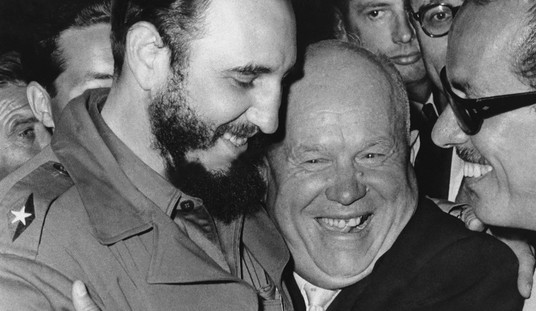The virus is “relatively contained” at this point in the same way that a fire in your home is “relatively contained” at a moment when only the living-room drapes are on fire.
Someday someone will explain to me why an economist is out in front of the cameras making happy talk about the outbreak of a virus no one’s ever seen before. If I were Trump, I’d fire Kudlow for this.
Kudlow: Buy on the dip, on COVID-19 "this is contained", "relatively contained." pic.twitter.com/iF4Nheem4i
— Josh Marshall (@joshtpm) March 6, 2020
Trump’s not going to fire him because Kudlow’s conveying exactly the message he wants him to convey. Reassure investors. Save the Dow. Worry about hard truths involving the spread of disease later. But investors aren’t stupid. They have lots of information about the virus beyond White House spin. We had a Fed rate cut this week, a blockbuster jobs report, and the president’s top economic advisor on TV offering morale boosters and the Dow still gained less than 400 points since it opened Monday. If not for a rally in the final hour of trading today, it would have finished down over the past five days. The feds are throwing everything they can at it but it’s not working because people know this thing is out of control even if the White House won’t admit it. They can read.
Here’s Trump with his own contribution to the bogus “containment” narrative.
Trump on the virus: “We closed it down. We stopped it.”
His lies and incompetence are going to get many killed.
https://t.co/IWTc3ZLsk2— George Takei (@GeorgeTakei) March 6, 2020
Time magazine has a worthy piece today about the administration’s coronavirus strategy. They’re a one-trick pony, and their one trick worked — for awhile. They stopped travel to China after the initial outbreak in Wuhan. That’s what Trump means here when he says “We stopped it.” They did at the very least slow down the virus’s entry into the United States; combined with China’s massive lockdown to contain the disease inside its borders, that bought the U.S. crucial time to prepare mass testing for the absolutely inevitable arrival of the disease here. Trump may have convinced himself that strong border enforcement, his pet issue, might prevent COVID-19 from ever crossing the Pacific. It was never going to prevent it but it did delay it.
And that should have been greatly useful to the CDC. To borrow the analogy from up top, you’re obviously far better prepared to put out a fire in your home if you’re standing right there with an extinguisher once it breaks out. But there was a problem: The CDC’s fire extinguisher didn’t work. They botched the test kits, for complicated scientific reasons. The cinders have now ignited the drapes. And the fire extinguisher, once it’s finally working, just isn’t big enough to stifle a fire that size.
We’re facing a catastrophe.
But the United States has lagged far behind the rest of the world in testing for the new coronavirus. As a result, outbreaks here are likely to be more numerous and more difficult to control than they would have been otherwise. I research infectious disease and how to fight it, so I know how important it is to detect outbreaks early. The covid-19 outbreak is the largest acute infectious-disease emergency most of us have experienced. And we may have let it go undetected here for too long…
Estimates suggest that about 1 in 50 people known to be infected die, so multiply the number of deaths by 50 to estimate the total cases. But that is not enough. It takes people quite a few weeks to die of covid-19, so when there’s a death, we have to go back to when that person was infected and ask how the outbreak grew since then. Current estimates are that it takes about a week for the number of cases to double, though there’s considerable uncertainty around the exact number. But if for each death, there were 49 other infections in the community when the patient who died became infected, then one week later, those cases would have grown to 98; after two weeks, to 196. If the patient dies three weeks after contracting covid-19, by that time, we would expect about 392 cases. That means for each dead body, a community already has hundreds of other cases, infected and infectious.
Two weeks ago, Italy was reporting 17 cases of COVID-19. Today they’re reporting 4,636.
The author quoted above went on to say, “I know of people right now, some of them front-line health-care workers (a group at particular risk for covid-19), who are sick and struggling to get tested.” A nurse in California put out a statement yesterday claiming that she’s sick, in quarantine, and still can’t get CDC approval to be tested because she was wearing protective gear while treating a coronavirus patient and therefore “shouldn’t” have the disease. Why would the CDC deny a test under those circumstances? Obviously it’s because testing capacity is still so low that they need to ration tests for the most questionable cases until production increases. Something similar allegedly happened to a Seattle resident, in the heart of the hot zone, who had coronavirus symptoms but couldn’t get tested because his lung X-rays looked normal. There aren’t enough tests to go around to waste one on someone like that. Hopefully widespread testing will begin within the next few weeks, he was told.
Two writers at the Atlantic called around to see if they could nail down exactly how many Americans in our nation of 330 million have been tested since we supposedly “closed it down” and “stopped it.”
Through interviews with dozens of public-health officials and a survey of local data from across the country, The Atlantic could only verify that 1,895 people have been tested for the coronavirus in the United States, about 10 percent of whom have tested positive. And while the American capacity to test for the coronavirus has ramped up significantly over the past few days, local officials can still test only several thousand people a day, not the tens or hundreds of thousands indicated by the White House’s promises…
The figures we gathered suggest that the American response to the coronavirus and the disease it causes, COVID-19, has been shockingly sluggish, especially compared with that of other developed countries. The CDC confirmed eight days ago that the virus was in community transmission in the United States—that it was infecting Americans who had neither traveled abroad nor were in contact with others who had. In South Korea, more than 66,650 people were tested within a week of its first case of community transmission, and it quickly became able to test 10,000 people a day. The United Kingdom, which has only 115 positive cases, has so far tested 18,083 people for the virus.
There’s no putting out the fire now. Our best strategy at this point is just to keep as many people as we can as far away from it as possible, i.e. “social distancing” by avoiding unnecessary crowds. A historian who studies pandemics revealed today that “school closing turned out to be one of the most effective firewalls against the spread of the pandemic” in the research he’s done, provided that the shutdowns occur “before, not after, the outbreak becomes widespread here.” Social distancing, in other words. Here’s what it can do, in a graph:
1. A very short thread on the power of data graphics and scientific communication.
Roughly a week ago, some very smart person* sat down, drew this graph, and saved lives.
(*It's 2 AM. Without an economist subscription, I can't quickly discover whom. Maybe someone can help.) pic.twitter.com/eU71Eu60eS
— Carl T. Bergstrom (@CT_Bergstrom) March 6, 2020
It won’t necessarily halt the disease’s spread but it’ll slow it down enough potentially so that everyone who needs a hospital bed can have one. The difference between the treatment you get in an ICU and in a high-school gym that’s been repurposed with cots because the hospital can’t house any more patients is apt to be significant, needless to say. And yet Seattle public schools announced yesterday that they … won’t be shutting down at this time. Even though the WHO has begun beating the drum that this is the moment to “pull out all the stops” to arrest the disease’s spread.
To sum all of this up in easy to understand terms, the general vibe right now is that moment in “Ghostbusters” when the EPA shuts down the grid. The people who know how this stuff works are side-eyeing each other and slowly backing away, aware of what’s coming even if the idiot from the federal government doesn’t.
Trump is at the CDC this afternoon for a goodwill visit, which must grate on him given the extent to which they’ve grossly failed at their core duty of preventing epidemics. (He temporarily canceled the visit this morning because of a scare there involving an employee whom they thought might have COVID-19.) He can’t fire them; he’s stuck with the team he’s got, however ineffectual. He could, though, at least cut the happy-talk crap and face reality squarely. Apparently he said this during his visit:
Trump on coronavirus testing: "Anybody who wants a test, gets a test. And they're beautiful."
— David Nakamura (@DavidNakamura) March 6, 2020
Yes, eventually that’ll be true. But not now. And not when it could have made a major difference to containing the disease’s spread, thanks to his friends at the CDC. He said this too, because not even an infectious outbreak that’s killed thousands already worldwide should be allowed to interrupt a grudge:
Trump on Inslee: "I told Mike not to be complimentary of that Gov because that Gov is a snake…Let me just tell you we have a lot of problems with the Gov and the Gov of WA, that's where you have many of your problems, OK? So Mike may be happy with him but I'm not OK?"
— Meridith McGraw (@meridithmcgraw) March 6, 2020
Here he is last night trying to put a happy face on the fact that the U.S. economy is destined to have far fewer foreign visitors because of coronavirus than it normally does, which will doubtless brutalize industries that rely on tourism. His theory is that Americans will fill that gap by touring the U.S. themselves instead of traveling abroad. In reality, airlines are already seeing sharp drop-offs in *domestic* travel for the obvious reason that people don’t want to visit airports at a moment when we’re supposed to be staying away from each other. So, I don’t know. Just back away from the grid and run.
Trump tries to find a silver lining to the coronavirus during Fox News town hall: "I have to say, people are now staying in the United States, spending their money in the US — and I like that." pic.twitter.com/lbERhrSq6t
— Aaron Rupar (@atrupar) March 5, 2020









Join the conversation as a VIP Member